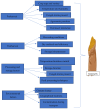Multiple Mycotoxin Contamination in Livestock Feed: Implications for Animal Health, Productivity, and Food Safety
- PMID: 40864041
- PMCID: PMC12389956
- DOI: 10.3390/toxins17080365
Multiple Mycotoxin Contamination in Livestock Feed: Implications for Animal Health, Productivity, and Food Safety
Abstract
Mycotoxins are toxic secondary metabolites produced by various fungi that contaminate livestock feed, posing serious threats to animal health, productivity, and food safety. Although historical research has often examined individual mycotoxins in isolation, real-world conditions typically involve the simultaneous presence of multiple mycotoxins, resulting in additive or synergistic toxic effects that are often more severe than those observed with single toxin exposures. This review comprehensively synthesizes recent findings on multi-mycotoxin contamination in livestock feed, highlighting their physiological effects, mechanisms of action, and implications for regulatory frameworks. Multi-mycotoxin interactions exacerbate oxidative stress, immune suppression, impaired reproduction, and organ damage across species, leading to reduced growth performance, decreased milk and egg production, compromised carcass and wool quality, and increased mortality rates. A major concern is that current international regulatory standards mainly address individual mycotoxins, overlooking the compounded risks of co-occurrence. Global surveillance studies consistently reveal high prevalence rates of mycotoxin mixtures in feedstuffs, especially combinations involving DON, ZEN, AFB1, FB1, and OTA. Understanding these interactions and their underlying cellular mechanisms is critical for improving risk assessment models, formulating integrated mitigation strategies, and safeguarding both livestock productivity and human food security.
Keywords: fungi; livestock; multi-occurrence; mycotoxicosis; mycotoxins.
Conflict of interest statement
The authors declare that there are no conflicts of interest.
Figures
Similar articles
-
Mycotoxins in Broiler Production: Impacts on Growth, Immunity, Vaccine Efficacy, and Food Safety.Toxins (Basel). 2025 May 22;17(6):261. doi: 10.3390/toxins17060261. Toxins (Basel). 2025. PMID: 40559839 Free PMC article. Review.
-
Ultraviolet processing for mycotoxin mitigation: A sustainable approach to enhancing food safety and security.Toxicon. 2025 Oct;265:108505. doi: 10.1016/j.toxicon.2025.108505. Epub 2025 Jul 24. Toxicon. 2025. PMID: 40714115 Review.
-
Prescription of Controlled Substances: Benefits and Risks.2025 Jul 6. In: StatPearls [Internet]. Treasure Island (FL): StatPearls Publishing; 2025 Jan–. 2025 Jul 6. In: StatPearls [Internet]. Treasure Island (FL): StatPearls Publishing; 2025 Jan–. PMID: 30726003 Free Books & Documents.
-
Mycotoxin contamination and control strategy in human, domestic animal and poultry: A review.Microb Pathog. 2020 May;142:104095. doi: 10.1016/j.micpath.2020.104095. Epub 2020 Feb 22. Microb Pathog. 2020. PMID: 32097745 Review.
-
Trichothecenes in Food and Feed, Relevance to Human and Animal Health and Methods of Detection: A Systematic Review.Molecules. 2021 Jan 16;26(2):454. doi: 10.3390/molecules26020454. Molecules. 2021. PMID: 33467103 Free PMC article.
References
-
- Neme K., Mohammed A. Mycotoxin occurrence in grains and the role of postharvest management as a mitigation strategy. A review. Food Control. 2017;78:412–425. doi: 10.1016/j.foodcont.2017.03.012. - DOI
-
- Siri-Anusornsak W., Kolawole O., Mahakarnchanakul W., Greer B., Petchkongkaew A., Meneely J., Elliott C., Vangnai K. The occurrence and co-occurrence of regulated, emerging, and masked mycotoxins in rice bran and maize from Southeast Asia. Toxins. 2022;14:567. doi: 10.3390/toxins14080567. - DOI - PMC - PubMed
Publication types
MeSH terms
Substances
LinkOut - more resources
Full Text Sources
Medical


